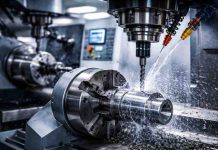Along California’s Interstate 5, where almond groves give way to warehouse sprawl, a gleaming electric semi pulls into a charging station that looks more like a miniature power plant than a gas pump. Solar panels stretch across the canopy, a small wind turbine spins lazily above the parking stalls and gleaming tanks of compressed hydrogen stand behind the chargers like sentinels. Inside a row of cabinets, batteries charge and discharge while an intelligent control system shuttles electrons and molecules between solar arrays, battery packs and electrolyzers. Software predicts when vehicles will arrive, dispatches power to the right port, and even sells surplus energy back to the grid. In the third quarter of 2025, nearly one third of all new cars sold in California were zero‑emission models, and the state has invested heavily in fast‑charging corridors to keep them moving. Yet the gleaming station off the I‑5 is more than a local curiosity. It is a window into a national transition to clean energy hubs that will demand new ideas about how to fuel freight and how to manage energy.
At the center of this work is Jeremiah Gbadegoye, a researcher at the University of Tennessee’s Resilient Energy and CO₂‑Optimized Intermodal Logistics (RECOIL) project. Working under the U.S. Department of Energy’s ARPA‑E INTERMODAL program the same agency that pioneered groundbreaking energy technologies Gbadegoye has spent the past several years designing and analyzing multi‑functional charging stations that combine battery electric charging, battery swapping, hydrogen refueling and renewable power generation in a single facility. His vision is to create energy hubs that can serve heavy trucks and passenger cars alike while acting as miniature grid resources. “These stations aren’t just plugs and hoses,” he explains. “They’re dynamic energy systems that think, react and generate revenue.”
Key Takeaways
- Clean energy hubs integrate multiple fuel sources, like hydrogen and electricity, to support diverse vehicles.
- Jeremiah Gbadegoye’s research focuses on developing energy hubs that combine charging and refueling with renewable power.
- Simulation models have shown that these hubs can generate profit while prioritizing renewable energy and reducing waste.
- Aligning with national transportation goals, clean energy hubs can enhance efficiency and reduce greenhouse gas emissions.
- Community engagement and policy support are essential for the successful deployment of clean energy hubs across the country.
Table of contents
A Digital Blueprint for the Future
To understand how such a complex system might work, Gbadegoye and his colleagues built a digital‑twin simulation that models a multi‑energy hub at five‑minute resolution. Presenting at the 2025 Winter Simulation Conference, their model couples solar and wind generation with battery storage, electrolyzers, high‑ and low‑pressure hydrogen tanks and fuel cells. It uses a priority‑based dispatch algorithm that serves hydrogen fuel‑cell trucks from high‑pressure tanks first, then allocates renewable energy to fast‑charging ports, draws from battery storage when needed, purchases from the grid when prices are favorable and, as a last resort, runs a fuel cell to keep the station operating. The simulation uses real data solar irradiation, wind speed, electricity prices and vehicle arrivals to see how the system responds hour by hour.
The results surprised even the researchers. Over a seven‑day period, the station not only met the energy demands of diverse vehicles but generated a net operational profit. The digital twin balanced energy flows across electricity and hydrogen, prioritized renewables, and minimized waste. It allowed the team to answer pressing questions before pouring concrete: How much wind power should be installed? When do battery swaps make more economic sense than fast charging? What happens when electricity prices spike or when trucks arrive in clusters? “A digital twin lets us explore thousands of ‘what if’ scenarios without building thousands of stations,” Gbadegoye says. “It’s a laboratory for investors and regulators to test policies and designs in silico before they commit capital.”
Making Clean Energy Hubs Pay
But building a station is only half the challenge; operating it profitably is just as important. Many charging networks struggle to recover their capital costs, and the addition of hydrogen systems and large batteries only increases complexity. In a second study submitted to Sustainable Energy, Grids and Networks, Gbadegoye developed an operational optimization model that schedules every aspect of a multi‑energy hub from when to run the electrolyzer or fuel cell to how much power to buy from or sell to the grid. The model coordinates electric‑vehicle charging, battery swapping and hydrogen refueling while allowing the station to participate in ancillary service markets such as spinning reserve and frequency regulation. It shows that sharing infrastructure using chargers and power assets for multiple services rather than dedicating them to a single fuel improves utilization and raises profits. In his work, shared configurations boosted daily profit by about eight percent, primarily by reducing idle equipment and enabling more grid services.
A key insight from the optimization model is the coupling of electricity and hydrogen systems: producing hydrogen when renewable output is high or grid prices are low and running the fuel cell when external power purchases are limited or expensive. This strategy makes the station resilient to price volatility and supply disruptions. “We’ve learned that multi‑energy hubs can be both environmentally beneficial and financially sustainable,” Gbadegoye notes. “They’re not just green infrastructure; they’re viable businesses when they participate in energy markets.”
Why Hydrogen Still Matters
The role of hydrogen in road transport remains the subject of intense debate. Battery electric cars have captured the passenger market, but fuel‑cell vehicles offer faster refueling and longer ranges for heavy trucks and buses. Hydrogen also provides a way to store excess renewable energy and to serve as backup power when the grid is strained. Today, fuel‑cell vehicles account for a tiny share of sales, but governments and manufacturers are setting ambitious targets and pilot projects are under way across Asia, Europe and North America. Integrating hydrogen production into charging stations creates synergy: electrolysers absorb surplus solar or wind power, preventing curtailment; fuel cells return electricity to the grid when demand peaks; and hydrogen tanks act as long‑duration storage, smoothing variability in renewable generation. The multi‑functional station thus becomes a microgrid clean energy hub, enhancing local grid stability and reducing the need for costly upgrades.
Aligning with National Policy and Industry Trends
Gbadegoye’s work comes at a moment when the United States is rethinking its transportation and energy infrastructure. The National Blueprint for Transportation Decarbonization, a joint plan issued in 2023 by the Departments of Energy, Transportation, Housing and Urban Development, and the Environmental Protection Agency, notes that road freight vehicles are among the largest contributors to greenhouse‑gas emissions and emphasizes that shifting to more efficient modes and cleaner fuels is essential to meet national climate goals. The blueprint highlights the importance of intermodal hubs that can optimize freight movement and support a shift to more efficient modes. At the same time, the Environmental Defense Fund’s report on Decarbonizing Long‑Haul Freight points out that rail is about four times as energy‑efficient as trucking and that shifting even twenty percent of long‑haul freight to intermodal rail could cut fuel use and emissions dramatically. Gbadegoye’s research draws on these national priorities: by creating stations where electric and hydrogen trucks can recharge and refuel, he is enabling the modal shift from road to rail and the electrification of heavy vehicles.
His work also aligns with the Department of Energy’s efforts to support ARPA‑E‑funded projects that marry advanced modelling with practical deployments. The RECOIL program’s goal is to reduce transportation emissions through data‑driven optimization and resilient infrastructure. The models and simulations developed by Gbadegoye’s team provide a blueprint for how to deploy charging and refueling hubs in ways that support supply‑chain resilience, reduce energy costs and meet decarbonization targets. By proving that multi‑energy hubs can be profitable, they give investors and policymakers confidence to scale up the technology.
Charting the Path Forward
Building the new grid of movement will require more than clever algorithms. Policy support and investment are critical. Just as tax credits and stricter emissions standards have spurred record sales of zero‑emission vehicles, similar mechanisms could accelerate deployment of multi‑energy hubs and hydrogen production. Regulators will need to adapt rules to accommodate emerging transportation technologies and to ensure data sharing between fleets and energy operators while protecting privacy and security. Continued research and development are essential. Uncertainties such as fluctuating electricity prices and unpredictable vehicle arrivals require robust decision‑making strategies, potentially drawing on artificial‑intelligence and machine‑learning methods. Advances in battery chemistry, hydrogen electrolysis and control algorithms will lower costs and improve efficiency.
Community engagement is also vital. Multi‑functional stations will change how drivers refuel and may reshape urban spaces and rural corridors. Transparent communication about the benefits and limitations of new technologies can build public trust. Demonstration projects that integrate clean energy hubs with fleets of electric trucks and buses can showcase success and surface challenges early. Gbadegoye emphasizes the need for partnerships between industry, government and academia to ensure that infrastructure investments serve both national climate goals and local needs.
A New Era of Resilient Mobility
The transition to a low‑carbon transportation system is not just about designing better batteries or building bigger chargers; it is about reimagining the infrastructure and operations that underpin mobility. By integrating solar, wind, battery and hydrogen systems and by leveraging advanced simulation and optimization, Jeremiah Gbadegoye and his colleagues have shown that clean energy hubs can be both resilient and economically sustainable. Their models balance energy resources in real time, participate in electricity and ancillary markets, and provide the flexibility required to support a rapidly growing fleet of electric and fuel‑cell vehicles. As heavy trucks haul goods across America and as states like California push toward zero‑emission transportation, the question is not whether the new grid of movement will appear, but how quickly. With thoughtful design and collaboration, the multi‑functional stations that Jeremiah Gbadegoye envisions may soon become a familiar sight not only along the I‑5 but across the country creating a transportation network that is cleaner, more resilient and ready for the next era.











